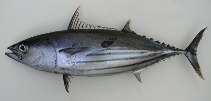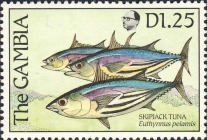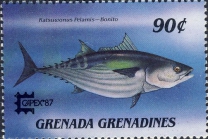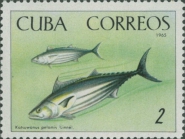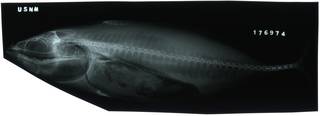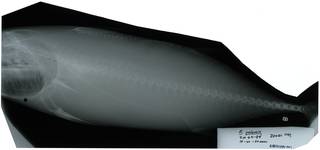WoRMS taxon details
Katsuwonus pelamis (Linnaeus, 1758)
127018 (urn:lsid:marinespecies.org:taxname:127018)
accepted
Species
Euthynnus pelamis (Linnaeus, 1758) · unaccepted (Subsequent combination)
Euthynnus pelamys (Linnaeus, 1758) · unaccepted (misspelling)
Gymnosarda pelamis (Linnaeus, 1758) · unaccepted
Gymnosarda pelamys (Linnaeus, 1758) · unaccepted (misspelling)
Katsowonus pelamis (Linnaeus, 1758) · unaccepted (misspelling)
Katsuwinus pelamis (Linnaeus, 1758) · unaccepted (misspelling)
Katsuwonis pelamis (Linnaeus, 1758) · unaccepted > misspelling - incorrect subsequent spelling
Katsuwonnus pelamis (Linnaeus, 1758) · unaccepted (misspelling)
Katsuwonus pelamsi (Linnaeus, 1758) · unaccepted (misspelling)
Katsuwonus pelamys (Linnaeus, 1758) · unaccepted (misspelling)
Katsuwonus vagans (Lesson, 1829) · unaccepted
Katuswonis pelamis (Linnaeus, 1758) · unaccepted > misspelling - incorrect subsequent spelling
Orcynus pelamis (Linnaeus, 1758) · unaccepted
Orcynus pelamys (Linnaeus, 1758) · unaccepted (misspelling)
Scomber pelamides Lacepède, 1801 · unaccepted
Scomber pelamis Linnaeus, 1758 · unaccepted
Scomber pelamys Linnaeus, 1758 · unaccepted (misspelling)
Thinnus pelamis (Linnaeus, 1758) · unaccepted
Thunnus pelamys (Linnaeus, 1758) · unaccepted (synonym)
Thynnus pelamis (Linnaeus, 1758) · unaccepted
Thynnus pelamys (Linnaeus, 1758) · unaccepted (misspelling)
Thynnus vagans Lesson, 1829 · unaccepted
marine, brackish, fresh, terrestrial
(of Scomber pelamis Linnaeus, 1758) Linnaeus, C. (1758). Systema Naturae per regna tria naturae, secundum classes, ordines, genera, species, cum characteribus, differentiis, synonymis, locis. [The system of nature through the three kingdoms of nature, according to classes, orders, genera, species, with characters, differences, synonyms, places.]. <em>Impensis Direct. Laurentii Salvii. Holmiae [Stockholm].</em> 1(10) [iii], 824 p., available online at https://biodiversitylibrary.org/page/726886 [details] Available for editors  [request]
[request]
(of Euthynnus pelamis (Linnaeus, 1758)) Linnaeus, C. (1758). Systema Naturae per regna tria naturae, secundum classes, ordines, genera, species, cum characteribus, differentiis, synonymis, locis. [The system of nature through the three kingdoms of nature, according to classes, orders, genera, species, with characters, differences, synonyms, places.]. <em>Impensis Direct. Laurentii Salvii. Holmiae [Stockholm].</em> 1(10) [iii], 824 p., available online at https://biodiversitylibrary.org/page/726886 [details] Available for editors [request]
[request]
(of Euthynnus pelamis (Linnaeus, 1758)) Linnaeus, C. (1758). Systema Naturae per regna tria naturae, secundum classes, ordines, genera, species, cum characteribus, differentiis, synonymis, locis. [The system of nature through the three kingdoms of nature, according to classes, orders, genera, species, with characters, differences, synonyms, places.]. <em>Impensis Direct. Laurentii Salvii. Holmiae [Stockholm].</em> 1(10) [iii], 824 p., available online at https://biodiversitylibrary.org/page/726886 [details] Available for editors
Description Found in offshore waters with temperatures ranging from 14.7 to 30°C while larvae are mostly restricted to waters with...
Distribution cosmopolitan in tropical and warm-temperate waters, as far north as 40.87°N
Description Found in offshore waters with temperatures ranging from 14.7 to 30°C while larvae are mostly restricted to waters with surface temperatures of at least 25°C. Exhibit a strong tendency to school in surface waters with birds, drifting objects, sharks, whales and may show a characteristic behaviour like jumping, feeding, foaming, etc. Feeds on fishes, crustaceans, cephalopods and molluscs. Spawns in batches all year long in tropical waters and from spring to early fall in subtropical waters. It is thought to live for at least 8-12 yrs. Also taken by trolling on light tackle using plugs, spoons, feathers, or strip bait (Ref. 9684). Marketed fresh, frozen or canned (Ref. 9340); also utilized dried-salted and smoked (Ref. 9987). [details]
Distribution cosmopolitan in tropical and warm-temperate waters, as far north as 40.87°N
Distribution cosmopolitan in tropical and warm-temperate waters, as far north as 40.87°N [details]
Froese, R. and D. Pauly. Editors. (2025). FishBase. Katsuwonus pelamis (Linnaeus, 1758). Accessed through: World Register of Marine Species at: https://www.marinespecies.org/aphia.php?p=taxdetails&id=127018 on 2025-04-01
Date
action
by
![]() The webpage text is licensed under a Creative Commons
Attribution-Noncommercial 4.0 License
The webpage text is licensed under a Creative Commons
Attribution-Noncommercial 4.0 License
Nomenclature
original description
(of Scomber pelamis Linnaeus, 1758) Linnaeus, C. (1758). Systema Naturae per regna tria naturae, secundum classes, ordines, genera, species, cum characteribus, differentiis, synonymis, locis. [The system of nature through the three kingdoms of nature, according to classes, orders, genera, species, with characters, differences, synonyms, places.]. <em>Impensis Direct. Laurentii Salvii. Holmiae [Stockholm].</em> 1(10) [iii], 824 p., available online at https://biodiversitylibrary.org/page/726886 [details] Available for editors  [request]
[request]
original description (of Euthynnus pelamis (Linnaeus, 1758)) Linnaeus, C. (1758). Systema Naturae per regna tria naturae, secundum classes, ordines, genera, species, cum characteribus, differentiis, synonymis, locis. [The system of nature through the three kingdoms of nature, according to classes, orders, genera, species, with characters, differences, synonyms, places.]. <em>Impensis Direct. Laurentii Salvii. Holmiae [Stockholm].</em> 1(10) [iii], 824 p., available online at https://biodiversitylibrary.org/page/726886 [details] Available for editors [request]
[request]
original description (of Scomber pelamides Lacepède, 1801) Lacepède, B.G.E. (1801). Histoire naturelle des poissons. 3: i-lxvi + 1-558, Pls. 1-34.
page(s): 14 [details]
basis of record van der Land, J.; Costello, M.J.; Zavodnik, D.; Santos, R.S.; Porteiro, F.M.; Bailly, N.; Eschmeyer, W.N.; Froese, R. (2001). Pisces, <B><I>in</I></B>: Costello, M.J. <i>et al.</i> (Ed.) (2001). <i>European register of marine species: a check-list of the marine species in Europe and a bibliography of guides to their identification. Collection Patrimoines Naturels,</i> 50: pp. 357-374 (look up in IMIS) [details]
original description (of Euthynnus pelamis (Linnaeus, 1758)) Linnaeus, C. (1758). Systema Naturae per regna tria naturae, secundum classes, ordines, genera, species, cum characteribus, differentiis, synonymis, locis. [The system of nature through the three kingdoms of nature, according to classes, orders, genera, species, with characters, differences, synonyms, places.]. <em>Impensis Direct. Laurentii Salvii. Holmiae [Stockholm].</em> 1(10) [iii], 824 p., available online at https://biodiversitylibrary.org/page/726886 [details] Available for editors
original description (of Scomber pelamides Lacepède, 1801) Lacepède, B.G.E. (1801). Histoire naturelle des poissons. 3: i-lxvi + 1-558, Pls. 1-34.
page(s): 14 [details]
basis of record van der Land, J.; Costello, M.J.; Zavodnik, D.; Santos, R.S.; Porteiro, F.M.; Bailly, N.; Eschmeyer, W.N.; Froese, R. (2001). Pisces, <B><I>in</I></B>: Costello, M.J. <i>et al.</i> (Ed.) (2001). <i>European register of marine species: a check-list of the marine species in Europe and a bibliography of guides to their identification. Collection Patrimoines Naturels,</i> 50: pp. 357-374 (look up in IMIS) [details]
Ecology
ecology source
Looby, A.; Erbe, C.; Bravo, S.; Cox, K.; Davies, H. L.; Di Iorio, L.; Jézéquel, Y.; Juanes, F.; Martin, C. W.; Mooney, T. A.; Radford, C.; Reynolds, L. K.; Rice, A. N.; Riera, A.; Rountree, R.; Spriel, B.; Stanley, J.; Vela, S.; Parsons, M. J. G. (2023). Global inventory of species categorized by known underwater sonifery. <em>Scientific Data.</em> 10(1). (look up in IMIS), available online at https://doi.org/10.1038/s41597-023-02745-4 [details] 
Other
context source (Deepsea)
Intergovernmental Oceanographic Commission (IOC) of UNESCO. The Ocean Biogeographic Information System (OBIS), available online at http://www.iobis.org/ [details]
context source (HKRMS) Hong Kong marine fish database. <em>AFCD.</em> , available online at https://www.hk-fish.net/en/fish/introduction/ [details]
context source (Bermuda) Smith-Vaniz, W. F.; Collette, B. B.; Luckhurst, B. E (1999). Fishes of Bermuda: History, zoogeography, annotated checklist, and identification keys (American Society of Ichthyologists and Herpetologists - Special Publication No.4) . ASIH, 424 pp. [details]
context source (PeRMS) Chirichigno, N.; Cornejo, M. (2001). Catálogo comentado de los peces marinos del Perú. <em>2ª ed. Instituto del Mar de Perú. Publicación Especial. Callao.</em> 314 p. [details]
additional source Gulf of Maine Biogeographic Information System (GMBIS) Electronic Atlas. 2002. November, 2002. [details]
additional source King, C.M.; Roberts, C.D.; Bell, B.D.; Fordyce, R.E.; Nicoll, R.S.; Worthy, T.H.; Paulin, C.D.; Hitchmough, R.A.; Keyes, I.W.; Baker, A.N.; Stewart, A.L.; Hiller, N.; McDowall, R.M.; Holdaway, R.N.; McPhee, R.P.; Schwarzhans, W.W.; Tennyson, A.J.D.; Rust, S.; Macadie, I. (2009). Phylum Chordata: lancelets, fishes, amphibians, reptiles, birds, mammals. <em>in: Gordon, D.P. (Ed.) (2009). New Zealand inventory of biodiversity: 1. Kingdom Animalia: Radiata, Lophotrochozoa, Deuterostomia.</em> pp. 431-554. [details]
additional source McEachran, J. D. (2009). Fishes (Vertebrata: Pisces) of the Gulf of Mexico, Pp. 1223–1316 in: Felder, D.L. and D.K. Camp (eds.), Gulf of Mexico–Origins, Waters, and Biota. Biodiversity. Texas A&M Press, College Station, Texas. [details]
additional source Liu, J.Y. [Ruiyu] (ed.). (2008). Checklist of marine biota of China seas. <em>China Science Press.</em> 1267 pp. (look up in IMIS) [details] Available for editors [request]
[request]
additional source Linnaeus, C. (1758). Systema Naturae per regna tria naturae, secundum classes, ordines, genera, species, cum characteribus, differentiis, synonymis, locis. [The system of nature through the three kingdoms of nature, according to classes, orders, genera, species, with characters, differences, synonyms, places.]. <em>Impensis Direct. Laurentii Salvii. Holmiae [Stockholm].</em> 1(10) [iii], 824 p., available online at https://biodiversitylibrary.org/page/726886
page(s): 297 [details] Available for editors [request]
[request]
additional source Wheeler, A. (1992). A list of the common and scientific names of fishes of the British Isles. <i>J. Fish Biol. 41(Suppl. A)</i>: 1-37 (look up in IMIS)
page(s): 297 [details]
additional source Froese, R. & D. Pauly (Editors). (2025). FishBase. World Wide Web electronic publication. version (06/2024)., available online at https://www.fishbase.org [details]
context source (HKRMS) Hong Kong marine fish database. <em>AFCD.</em> , available online at https://www.hk-fish.net/en/fish/introduction/ [details]
context source (Bermuda) Smith-Vaniz, W. F.; Collette, B. B.; Luckhurst, B. E (1999). Fishes of Bermuda: History, zoogeography, annotated checklist, and identification keys (American Society of Ichthyologists and Herpetologists - Special Publication No.4) . ASIH, 424 pp. [details]
context source (PeRMS) Chirichigno, N.; Cornejo, M. (2001). Catálogo comentado de los peces marinos del Perú. <em>2ª ed. Instituto del Mar de Perú. Publicación Especial. Callao.</em> 314 p. [details]
additional source Gulf of Maine Biogeographic Information System (GMBIS) Electronic Atlas. 2002. November, 2002. [details]
additional source King, C.M.; Roberts, C.D.; Bell, B.D.; Fordyce, R.E.; Nicoll, R.S.; Worthy, T.H.; Paulin, C.D.; Hitchmough, R.A.; Keyes, I.W.; Baker, A.N.; Stewart, A.L.; Hiller, N.; McDowall, R.M.; Holdaway, R.N.; McPhee, R.P.; Schwarzhans, W.W.; Tennyson, A.J.D.; Rust, S.; Macadie, I. (2009). Phylum Chordata: lancelets, fishes, amphibians, reptiles, birds, mammals. <em>in: Gordon, D.P. (Ed.) (2009). New Zealand inventory of biodiversity: 1. Kingdom Animalia: Radiata, Lophotrochozoa, Deuterostomia.</em> pp. 431-554. [details]
additional source McEachran, J. D. (2009). Fishes (Vertebrata: Pisces) of the Gulf of Mexico, Pp. 1223–1316 in: Felder, D.L. and D.K. Camp (eds.), Gulf of Mexico–Origins, Waters, and Biota. Biodiversity. Texas A&M Press, College Station, Texas. [details]
additional source Liu, J.Y. [Ruiyu] (ed.). (2008). Checklist of marine biota of China seas. <em>China Science Press.</em> 1267 pp. (look up in IMIS) [details] Available for editors
additional source Linnaeus, C. (1758). Systema Naturae per regna tria naturae, secundum classes, ordines, genera, species, cum characteribus, differentiis, synonymis, locis. [The system of nature through the three kingdoms of nature, according to classes, orders, genera, species, with characters, differences, synonyms, places.]. <em>Impensis Direct. Laurentii Salvii. Holmiae [Stockholm].</em> 1(10) [iii], 824 p., available online at https://biodiversitylibrary.org/page/726886
page(s): 297 [details] Available for editors
additional source Wheeler, A. (1992). A list of the common and scientific names of fishes of the British Isles. <i>J. Fish Biol. 41(Suppl. A)</i>: 1-37 (look up in IMIS)
page(s): 297 [details]
additional source Froese, R. & D. Pauly (Editors). (2025). FishBase. World Wide Web electronic publication. version (06/2024)., available online at https://www.fishbase.org [details]
 Present
Present  Present in aphia/obis/gbif/idigbio
Present in aphia/obis/gbif/idigbio  Inaccurate
Inaccurate  Introduced: alien
Introduced: alien  Containing type locality
Containing type locality
Unreviewed
Description Found in offshore waters with temperatures ranging from 14.7 to 30°C while larvae are mostly restricted to waters with surface temperatures of at least 25°C. Exhibit a strong tendency to school in surface waters with birds, drifting objects, sharks, whales and may show a characteristic behaviour like jumping, feeding, foaming, etc. Feeds on fishes, crustaceans, cephalopods and molluscs. Spawns in batches all year long in tropical waters and from spring to early fall in subtropical waters. It is thought to live for at least 8-12 yrs. Also taken by trolling on light tackle using plugs, spoons, feathers, or strip bait (Ref. 9684). Marketed fresh, frozen or canned (Ref. 9340); also utilized dried-salted and smoked (Ref. 9987). [details]Diet Feed on fishes, crustaceans, cephalopods and mollusks; cannibalism is common [details]
Distribution cosmopolitan in tropical and warm-temperate waters, as far north as 40.87°N [details]
Habitat Found in offshore waters; larvae restricted to waters with surface temperatures of 15°C to 30°C. [details]
Habitat nektonic [details]
Habitat Known from seamounts and knolls [details]
Importance Social- Commercial, fishery and gamefish [details]
| Language | Name | |
|---|---|---|
| Basque | lanpo sabelmarradun | [details] |
| Catalan | bonítol ratllat | [details] |
| Danish | bugstribet bonnit | [details] |
| Dutch | tonijngestreepte tonijn | [details] |
| English | skipjack tunaoceanic bonito | [details] |
| Finnish | boniitti | [details] |
| French | thonine à ventre rayéthonlistaobonite à ventre rayé | [details] |
| Galician | atún listado | [details] |
| German | Thunfishechter Bonitobauchstreifiger Bonito | [details] |
| Italian | tonneto striato | [details] |
| Japanese | カツオ | [details] |
| Modern Greek (1453-) | Ρίκι | [details] |
| Norwegian | stripet pelamide | [details] |
| Portuguese | bonito | [details] |
| Russian | скипджекПолосатый тунец | [details] |
| Spanish | listadobarrilete listado | [details] |
| Swedish | bonit | [details] |
| Turkish | cizgili tonito | [details] |
To Barcode of Life (367 barcodes)
To Biodiversity Heritage Library (1 publication) (from synonym Orcynus pelamis (Linnaeus, 1758))
To Biodiversity Heritage Library (1 publication) (from synonym Katsowonus pelamis (Linnaeus, 1758))
To Biodiversity Heritage Library (10 publications) (from synonym Scomber pelamides Lacepède, 1801)
To Biodiversity Heritage Library (12 publications) (from synonym Thunnus pelamys (Linnaeus, 1758))
To Biodiversity Heritage Library (20 publications) (from synonym Euthynnus pelamys (Linnaeus, 1758))
To Biodiversity Heritage Library (208 publications) (from synonym Thynnus pelamys (Linnaeus, 1758))
To Biodiversity Heritage Library (22 publications) (from synonym Gymnosarda pelamys (Linnaeus, 1758))
To Biodiversity Heritage Library (22 publications) (from synonym Thynnus vagans Lesson, 1829)
To Biodiversity Heritage Library (25 publications) (from synonym Thynnus pelamis (Linnaeus, 1758))
To Biodiversity Heritage Library (3 publications) (from synonym Katsuwonnus pelamis (Linnaeus, 1758))
To Biodiversity Heritage Library (39 publications) (from synonym Orcynus pelamys (Linnaeus, 1758))
To Biodiversity Heritage Library (45 publications) (from synonym Euthynnus pelamis (Linnaeus, 1758))
To Biodiversity Heritage Library (5 publications) (from synonym Thinnus pelamis (Linnaeus, 1758))
To Biodiversity Heritage Library (5 publications) (from synonym Katsuwonus pelamys (Linnaeus, 1758))
To Biodiversity Heritage Library (66 publications) (from synonym Scomber pelamis Linnaeus, 1758)
To Biodiversity Heritage Library (83 publications) (from synonym Gymnosarda pelamis (Linnaeus, 1758))
To Biodiversity Heritage Library (85 publications)
To Biodiversity Heritage Library (89 publications) (from synonym Scomber pelamys Linnaeus, 1758)
To Biological Information System for Marine Life (BISMaL)
To Dyntaxa
To European Nucleotide Archive, ENA (Katsuwonus pelamis)
To FAO Species fact sheets
To FishBase
To FishBase (from synonym Scomber pelamides Lacepède, 1801)
To FishBase (from synonym Orcynus pelamis (Linnaeus, 1758))
To FishBase (from synonym Euthynnus pelamis (Linnaeus, 1758))
To FishBase (from synonym Gymnosarda pelamis (Linnaeus, 1758))
To FishBase (from synonym Scomber pelamis Linnaeus, 1758)
To FishBase (from synonym Thynnus pelamis (Linnaeus, 1758))
To FishBase (from synonym Thynnus vagans Lesson, 1829)
To FishBase (from synonym Thinnus pelamis (Linnaeus, 1758))
To FishBase (from synonym Orcynus pelamys (Linnaeus, 1758))
To FishBase (from synonym Euthynnus pelamys (Linnaeus, 1758))
To FishBase (from synonym Scomber pelamys Linnaeus, 1758)
To FishBase (from synonym Katsuwonus pelamys (Linnaeus, 1758))
To FishBase (from synonym Katsuwonnus pelamis (Linnaeus, 1758))
To FishBase (from synonym Thynnus pelamys (Linnaeus, 1758))
To FishBase (from synonym Katsowonus pelamis (Linnaeus, 1758))
To FishBase (from synonym Katsuwonus pelamsi (Linnaeus, 1758))
To FishBase (from synonym Katsuwinus pelamis (Linnaeus, 1758))
To FishBase (from synonym Gymnosarda pelamys (Linnaeus, 1758))
To FishBase images (Katsuwonus pelamis, Cape Verde, by Freitas, R.)
To FishSounds
To GenBank (1726 nucleotides; 709 proteins)
To GenBank (1726 nucleotides; 709 proteins) (from synonym Euthynnus pelamis (Linnaeus, 1758))
To GenBank (1726 nucleotides; 709 proteins) (from synonym Scomber pelamis Linnaeus, 1758)
To Global Biotic Interactions (GloBI)
To IUCN Red List (Least Concern)
To NMNH Extant Collection (Katsuwonus pelamis RAD111598-001)
To NMNH Extant Collection (Katsuwonus pelamis RAD111599-001)
To PESI
To ITIS
To Biodiversity Heritage Library (1 publication) (from synonym Orcynus pelamis (Linnaeus, 1758))
To Biodiversity Heritage Library (1 publication) (from synonym Katsowonus pelamis (Linnaeus, 1758))
To Biodiversity Heritage Library (10 publications) (from synonym Scomber pelamides Lacepède, 1801)
To Biodiversity Heritage Library (12 publications) (from synonym Thunnus pelamys (Linnaeus, 1758))
To Biodiversity Heritage Library (20 publications) (from synonym Euthynnus pelamys (Linnaeus, 1758))
To Biodiversity Heritage Library (208 publications) (from synonym Thynnus pelamys (Linnaeus, 1758))
To Biodiversity Heritage Library (22 publications) (from synonym Gymnosarda pelamys (Linnaeus, 1758))
To Biodiversity Heritage Library (22 publications) (from synonym Thynnus vagans Lesson, 1829)
To Biodiversity Heritage Library (25 publications) (from synonym Thynnus pelamis (Linnaeus, 1758))
To Biodiversity Heritage Library (3 publications) (from synonym Katsuwonnus pelamis (Linnaeus, 1758))
To Biodiversity Heritage Library (39 publications) (from synonym Orcynus pelamys (Linnaeus, 1758))
To Biodiversity Heritage Library (45 publications) (from synonym Euthynnus pelamis (Linnaeus, 1758))
To Biodiversity Heritage Library (5 publications) (from synonym Thinnus pelamis (Linnaeus, 1758))
To Biodiversity Heritage Library (5 publications) (from synonym Katsuwonus pelamys (Linnaeus, 1758))
To Biodiversity Heritage Library (66 publications) (from synonym Scomber pelamis Linnaeus, 1758)
To Biodiversity Heritage Library (83 publications) (from synonym Gymnosarda pelamis (Linnaeus, 1758))
To Biodiversity Heritage Library (85 publications)
To Biodiversity Heritage Library (89 publications) (from synonym Scomber pelamys Linnaeus, 1758)
To Biological Information System for Marine Life (BISMaL)
To Dyntaxa
To European Nucleotide Archive, ENA (Katsuwonus pelamis)
To FAO Species fact sheets
To FishBase
To FishBase (from synonym Scomber pelamides Lacepède, 1801)
To FishBase (from synonym Orcynus pelamis (Linnaeus, 1758))
To FishBase (from synonym Euthynnus pelamis (Linnaeus, 1758))
To FishBase (from synonym Gymnosarda pelamis (Linnaeus, 1758))
To FishBase (from synonym Scomber pelamis Linnaeus, 1758)
To FishBase (from synonym Thynnus pelamis (Linnaeus, 1758))
To FishBase (from synonym Thynnus vagans Lesson, 1829)
To FishBase (from synonym Thinnus pelamis (Linnaeus, 1758))
To FishBase (from synonym Orcynus pelamys (Linnaeus, 1758))
To FishBase (from synonym Euthynnus pelamys (Linnaeus, 1758))
To FishBase (from synonym Scomber pelamys Linnaeus, 1758)
To FishBase (from synonym Katsuwonus pelamys (Linnaeus, 1758))
To FishBase (from synonym Katsuwonnus pelamis (Linnaeus, 1758))
To FishBase (from synonym Thynnus pelamys (Linnaeus, 1758))
To FishBase (from synonym Katsowonus pelamis (Linnaeus, 1758))
To FishBase (from synonym Katsuwonus pelamsi (Linnaeus, 1758))
To FishBase (from synonym Katsuwinus pelamis (Linnaeus, 1758))
To FishBase (from synonym Gymnosarda pelamys (Linnaeus, 1758))
To FishBase images (Katsuwonus pelamis, Cape Verde, by Freitas, R.)
To FishSounds
To GenBank (1726 nucleotides; 709 proteins)
To GenBank (1726 nucleotides; 709 proteins) (from synonym Euthynnus pelamis (Linnaeus, 1758))
To GenBank (1726 nucleotides; 709 proteins) (from synonym Scomber pelamis Linnaeus, 1758)
To Global Biotic Interactions (GloBI)
To IUCN Red List (Least Concern)
To NMNH Extant Collection (Katsuwonus pelamis RAD111598-001)
To NMNH Extant Collection (Katsuwonus pelamis RAD111599-001)
To PESI
To ITIS
From editor or global species database
Unreviewed
